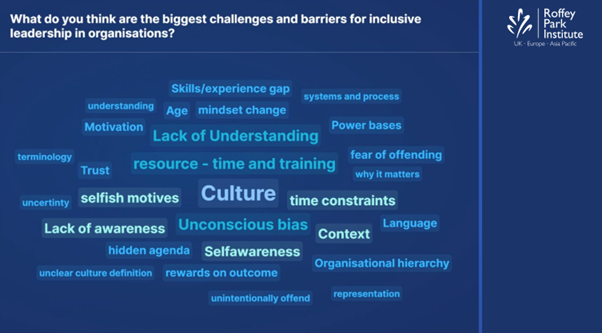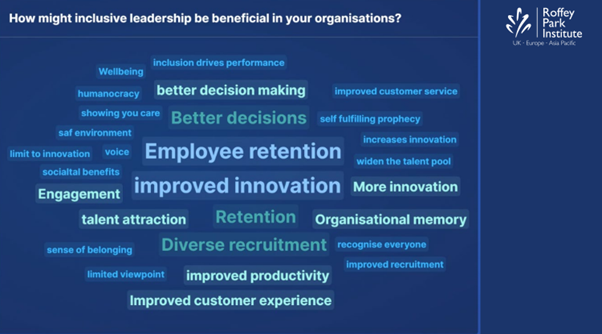On Tuesday I attended the Inclusive Leadership Navigator virtual event at Roffey Park Institute, led by the expert Sile Walsh, to explore how inclusive leadership contributes to psychological safety, organisational performance and employee engagement.
The discussion began by asking the listeners to answer some questions about their experiences with inclusion and exclusion. The responses were striking. When asked if they exclude people intentionally? 18% answered yes and 82% no. When asked if they themselves have felt excluded, the response was 50/50. This begs the obvious question, how can there be such a disparity between practising inclusivity and feeling included?
What Isn’t Inclusive Leadership?
Sile, as well as the virtual chat discussion, drew upon a few possible reasons why there was such a disparity. Inclusive leadership is not about being nice or PC; it is not about knowing everything about diversity labels and needs; it is not about never making a mistake; it is not simply a tick box exercise and it is not the sole responsibility of senior leaders. Inclusivity has become somewhat of a buzzword; a lot of people are saying it but not doing it. We were asked, ‘What do you think are the biggest challenges and barriers for inclusive leadership in organisations?’ Here were the responses (the larger the word/phrase, the more times it was said).

Phrases like ‘lack of’ and ‘fear’ came up a number of times during the event and understandably so. But as we have mentioned, inclusive leadership is not about never making a mistake, in fact, inclusive leadership is about bringing curiosity. Sile explained that exclusion is a natural part of human processes, we have to prioritise what is important or not but in doing so ensure that what we do is not discriminatory or done with an unconscious narrative. There is no shame in making mistakes; inclusivity is a process, not a concept. Always being curious means continuing to be inclusive. It is much more useful to make a mistake than it is a simple tick box exercise.
Inclusive Leadership is for the now
Understanding the challenges naturally led us onto looking ahead at how inclusive leadership can be beneficial in organisations. Current legislation requires we do not discriminate but not that we include, so it is extremely important that we begin to have these conversations. We were asked, ‘How might inclusive leadership be beneficial in your organisations?’

These breakout sessions created the space to discuss our own personal contexts and it was really effective. After discussing some of the popular themes to have come out of the group discussions, Sile shared some research findings into the positive impact of inclusive leadership.
The event concluded with considerations on how to bring inclusive leadership to life in organisations. Sile explained how completing self-assessments and encouraging open conversations could be a more effective way of trying to enact change rather than enforcing power. Other considerations included internal practices, middle and senior management rewarded for being inclusive, formal leaders championing inclusion, fostering a learning environment, using coaching approaches in conversation and awareness of inclusive leadership, psychological safety and its relation with performance.
The event closed after an insightful Q&A session. Sile’s enthusiasm and passion contagiously spread throughout the group. A constant discussion flowed in the chat function from start to finish and, from my experience, participants were present and contributed well within the breakout groups. It was an engaging and fascinating event that helped define the difference between discrimination and exclusion in the workplace and explain the importance of inclusive leadership and that the ability to include is a fundamental and essential part of healthy organisational culture.
Looking ahead
It is useful to understand that inclusion does not lie strictly with the senior leaders of an organisation; it is about having those open conversations and using the correct language throughout an organisation. Influencing does not necessarily mean solely downwards; it can be sideways and upwards. I think it is up to all of us to encourage open discussions about inclusive leadership and intentional and unintentional exclusion and to promote curiosity so we can continue to learn.





